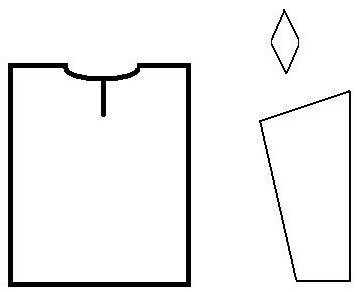Shirts
Shirts
Every male member of society wore shirts, they were considered an essential part of your wardrobe. A shirt was part of your underwear, together with the braies and coif, and would have been one of the rare items that were washed regularly. For modern re-enactment and comfort I would suggest that you make several shirts, they are good for sleeping in too.
Making Shirts
Material: A good soft plain linen. Colour: Off-white or cream, getting whiter as you get better station.
-
A basic shirt is very simple as it is made up of rectangles. It is really just an oblong shape with a hole cut out for the head. If you have a wide enough material you can fold it in half to make the shoulders and cut out the body all in one, to be sewn up the centre of the back. Measure your chest and hips and add some moving around room (about 10cm). Measure from your shoulder to about 10cm below your groin. You may want to add some flare as you near your hips.
-
To make your sleeve pattern; measure the outside and inside of your arm, from the top of your shoulder down to your knuckles. Add 10cm to each of these measurements (to allow for movement and seam allowance). Mark this length on your piece of paper.
-
Measure your fist circumference and divide by 2 and add 5cm. Then measure from under your arm to the top of your shoulder and add 10 cm. Draw all of these measurements on to your half sleeve pattern.
-
Fold your remaining material in two, making sure you place your long shoulder to knuckle part against the fold. Cut out the sleeve and repeat for the second sleeve.
-
Sew up the body and sleeve sides. You may want to add in a gusset to allow extra movement. This is an elongated diamond 12cm by 6cm sewn on the join around the armpit, between the sleeve and body seams. The sleeves may need folding pleats to fit the body piece.
-
Cut an area for your head and hand sew with running stitch. You may like to add a collar here too.
-
Fold over the waist and cuffs twice by 1cm and finish off with a running stitch.
-
Sew the remaining raw edges to prevent fraying

